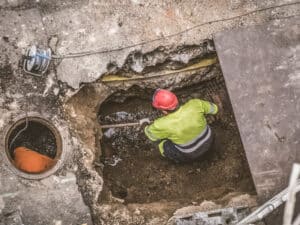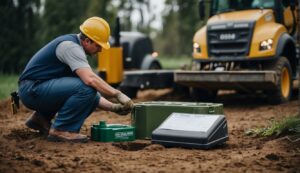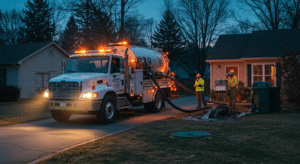Septic systems are a critical component of any home or property that is not connected to a central sewer system. Over time, however, traditional septic or cesspool systems can become outdated, inefficient, and potentially harmful to the environment. That’s why many homeowners are considering upgrading to an advanced I/A OWTS septic system. In this article, we’ll answer some of the most frequently asked questions about I/A OWTS septic systems.
What is an I/A OWTS septic system?
An I/A OWTS septic system, also known as an advanced septic system, is a modern and efficient alternative to traditional septic or cesspool systems. These systems are designed to reduce the environmental impact of traditional systems by treating wastewater to a higher standard before it is released into the environment.
I/A OWTS septic systems use a combination of mechanical and biological processes to treat the wastewater generated by a home or property. This wastewater is typically composed of wastewater from sinks, toilets, showers, and other sources. The wastewater is pumped into a septic tank where it is treated by bacteria and other microorganisms to remove harmful contaminants. The treated wastewater is then pumped into a drainfield, where it is further treated and released into the environment.
What are the benefits of an I/A OWTS septic system?
There are several benefits of upgrading to an I/A OWTS septic system, including:
- Improved Efficiency
I/A OWTS septic systems are designed to be more efficient and require less maintenance than traditional systems. This means that you will likely save money on maintenance and repair costs over the lifetime of the system. Additionally, these systems use less water than traditional systems, which can lead to further cost savings. - Increased Property Value
Upgrading to an I/A OWTS septic system can also have a positive impact on the value of your property. In many cases, a home with a modern and efficient septic system is more desirable and can command a higher price on the real estate market. Additionally, a well-maintained septic system can add to the overall value of a property, making it a wise investment for homeowners. - Environmental Protection
I/A OWTS septic systems are also more environmentally friendly than traditional systems. By reducing the risk of groundwater contamination, you can help protect the environment and avoid costly fines and penalties imposed by local and state regulations. Additionally, these systems use less water than traditional systems, which can help conserve water resources in regions where water is scarce. - Improved Health and Safety
An I/A OWTS septic system can also help improve the health and safety of a home or property. By treating wastewater to a higher standard, these systems reduce the risk of harmful pathogens and contaminants from entering the environment. Additionally, many I/A OWTS septic systems are equipped with alarms that can alert homeowners in the event of a malfunction, allowing for quick and effective repairs.
What are the costs involved in upgrading to an I/A OWTS septic system?
The cost of installing an I/A OWTS septic system varies based on the size of the system, the complexity of the installation, and the local regulations in your area. On average, you can expect to pay anywhere from $10,000 to $30,000 for a complete installation of an I/A OWTS septic system.
However, it’s important to note that this is just an average and costs can vary significantly based on the specific needs of your home or property. For example, properties with challenging topography or limited access to wastewater may require additional excavation or construction work, which can increase the overall cost of the project. Additionally, some states and localities offer grants and rebates to homeowners who install advanced septic systems, which can help offset the costs of the project.
Many companies like Bridgewater Environmental will help you get the maximum amount of grant and rebate money available which can potentially cover 100% of the installation costs.
It’s also worth considering that the cost of upgrading to an I/A OWTS septic system can be offset by the long-term benefits of the system. By reducing septic system maintenance and repair costs, conserving water, and increasing the value of your property, you can save money over the lifetime of the system.
What is involved in the installation of an I/A OWTS septic system?
The installation of an I/A OWTS septic system involves several key steps, including:
- Site Assessment
Before installation can begin, a site assessment must be conducted to determine the best location for the septic tank, drainfield, and other components of the system. The site assessment should also take into account the local regulations and requirements for septic systems in your area. - Excavation
Once the site has been assessed, excavation work will begin to create a space for the septic tank and drainfield. This work may involve removing soil and other materials from the site, as well as preparing the site for the installation of the septic tank and drainfield. - Installation of Septic Tank and Drainfield
The next step in the installation process is the installation of the septic tank and drainfield. This may involve connecting the tank and drainfield to the home or property’s wastewater pipes, as well as installing any other components of the system, such as pumps or alarms. - Backfill and Grading
After the septic tank and drainfield have been installed, the site will be backfilled and graded to ensure proper drainage and to prevent damage to the system over time. - System Start-up
The final step in the installation process is the start-up of the system. This involves testing the system to ensure that it is functioning properly and that it is in compliance with local regulations and requirements.
What is involved in maintaining an I/A OWTS septic system?
Maintaining an I/A OWTS septic system is critical to ensuring that the system continues to function properly and to avoid costly repairs or replacements. Regular maintenance tasks include:
- Pumping Out the Septic Tank
Depending on the manufacturer, size, and installation details, an I/A OWTS septic tank should be pumped out every three to five years to remove any buildup of sludge and scum. - Inspecting the System
An annual inspection of the system should be conducted to ensure that it is functioning properly and to identify any potential problems. - Keeping the Drainfield Clear
The drainfield should be kept free of trees, shrubs, and other vegetation that can interfere with the functioning of the system. - Conserving Water
Conserving water can help prolong the life of your I/A OWTS septic system by reducing the amount of wastewater that needs to be treated.
By following these simple maintenance tasks, you can help ensure that your I/A OWTS septic system continues to function properly and to provide you with the many benefits of a modern and efficient septic system.
Upgrading to an I/A OWTS septic system is a smart investment for homeowners who want to improve the efficiency and performance of their septic systems. If you have any further questions about I/A OWTS septic systems, feel free to reach out to Bridgewater Environmental for any further information or guidance you need to make an informed decision about upgrading your septic system.









